Arthrosis knee joint- a disease that gradually leads to the destruction of cartilage tissue. Chondroprotectors will help to eliminate pain, restore intra-articular fluid - effective drugs for the treatment of arthrosis, which have anti-inflammatory, analgesic effects.
Chondroprotectors for arthrosis are medicines that effectively restore delicate cartilage tissue. They are widely used to treat inflammatory diseases knee joint. They have a beneficial effect on the problem area, reducing the intensity of pain.
What are the drugs of this group?
Chondroprotectors are drugs of synthetic, biological origin. The main action of medications is the restoration of hyaline intra-articular cartilage. This means that by taking such medications, the patient protects and partially restores the joints damaged by arthrosis. Hondoprotectors have one feature - a gradually increasing therapeutic effect.
The active substances containing drugs for the treatment of the disease, only after a while, are included in the metabolic processes of the human body, gradually becoming part of the cartilage, thereby improving the characteristics of the fluid inside the joint. To achieve such a result, long-term therapy with drugs of this group will be required.
Important! Chondroprotectors are drugs used to treat arthrosis, the effectiveness of which depends on the severity of diseases and destructive tissue disorders. A positive result should not be expected when the joint is already destroyed.
Indications for the appointment of chondroprotectors
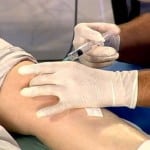
Drugs in this group are used in the presence of the following diseases:
- arthrosis: gonarthrosis, small joints;
- osteochondrosis;
- arthritis: periarticular, joint ailments occurring in the presence of inflammation;
- dystrophic lesions of cartilage;
- trauma, spondylosis;
- periodontal disease;
- after surgery to restore joint function.
How chondroprotectors work
 With arthrosis, degenerative, dystrophic processes are observed in the cartilaginous substance, which reduce motor activity, leading to discomfort, changes in the joints. Drugs used to treat diseases must repair damaged tissue.
With arthrosis, degenerative, dystrophic processes are observed in the cartilaginous substance, which reduce motor activity, leading to discomfort, changes in the joints. Drugs used to treat diseases must repair damaged tissue.
The composition of chondroprotectors includes glucosamine, chondroitin sulfate - active components capable of:
- to revive the reaction of synthesis of the main components of the joint tissue;
- prevent changes in cartilage tissue;
- have a regenerating, anti-inflammatory effect;
- start the reproduction of fluid inside the joint.
Most chondroprotectors contain glucosamine or chondroitin exclusively. But the best drugs contain several active substances in various proportions, therefore they are more effective for treating the disease.
Classification of medicines with chondroprotective action
 Chondroprotectors for arthrosis are divided into three headings, depending on the start of use and the time of their appearance:
Chondroprotectors for arthrosis are divided into three headings, depending on the start of use and the time of their appearance:
- The first is biological preparations. natural origin created by the type of effective extracts from the intra-articular tissue of fish and animals.
- The second is medicines, which include one of the active ingredients: glucosamine, chondroitin or hyaluronic acid.
- The third is the combination drugs used to treat arthrosis, they contain different combinations of chondroitin, glucosamine and hyaluronic acid. They often include chondroitin and glucosamine.
The choice of medicines for the treatment of arthrosis
The network of pharmacies presents a wide range of medicines of this group, according to the instructions - they are similar to each other in dosage and content. Initial data about your illness and the recommendations of orthopedic surgeons will help you not to make a mistake with the choice. It is he who can prescribe the appropriate therapy to the patient. And choose the best ointments.
The drugs prescribed for the treatment of arthrosis can differ in the percentage of active substances, the degree of purification of raw materials, their sources and the presence of additives.
Dear best chondroprotectors for arthrosis of the knee joint, which have long proven themselves on the positive side, have been tested, and there is also reliable data on their effectiveness. In addition, they are maximally cleared of various impurities. This means that allergic reactions, possible side effects reduced to a minimum.
Usually, drugs in this group are well tolerated by patients, undesirable effects are noted only occasionally. Among them are: gastrointestinal disorders, nausea, diarrhea, vomiting, allergies. Often, such phenomena are not provoked by active ingredients, but by additives, impurities, which are in various quantities. The main substances - glucosamine and chondroitin - are natural components that are similar in characteristics to the human body, therefore they are safe.
Contraindications to the appointment
 Chondroprotectors for joint inflammation are not used in the following cases:
Chondroprotectors for joint inflammation are not used in the following cases:
- lactation, waiting period for crumbs;
- children under 12 years old;
- an individual reaction to a certain component of the drug (a similar drug or another drug is prescribed);
- severe ailments of the gastrointestinal tract (the use of medicines in tablet form is excluded);
- advanced arthrosis - due to the impossibility of achieving a positive effect.
The use of tablets for the treatment of arthrosis
Tableted combined chondroprotectors: "Movex", "Teraflex" are endowed with the necessary therapeutic effect. They are prescribed for stages 1-3 of the disease, in combination with local therapy, through ointments. For optimal results, therapy should be continued.
The duration of treatment is from 3 to 4 months, depending on the severity of the disease. This feature must be taken into account by patients. You should not expect an instant result from the use of chondroprotectors in the form of tablets, as it occurs as the joints recover and strengthen. Single-component medicines ("Glucosamine", "Chondroitin", "Don") are less effective, but their cost is an order of magnitude lower than the combined ones. In this connection, they are prescribed at the first stage of gonarthrosis.
The use of medicinal ointments
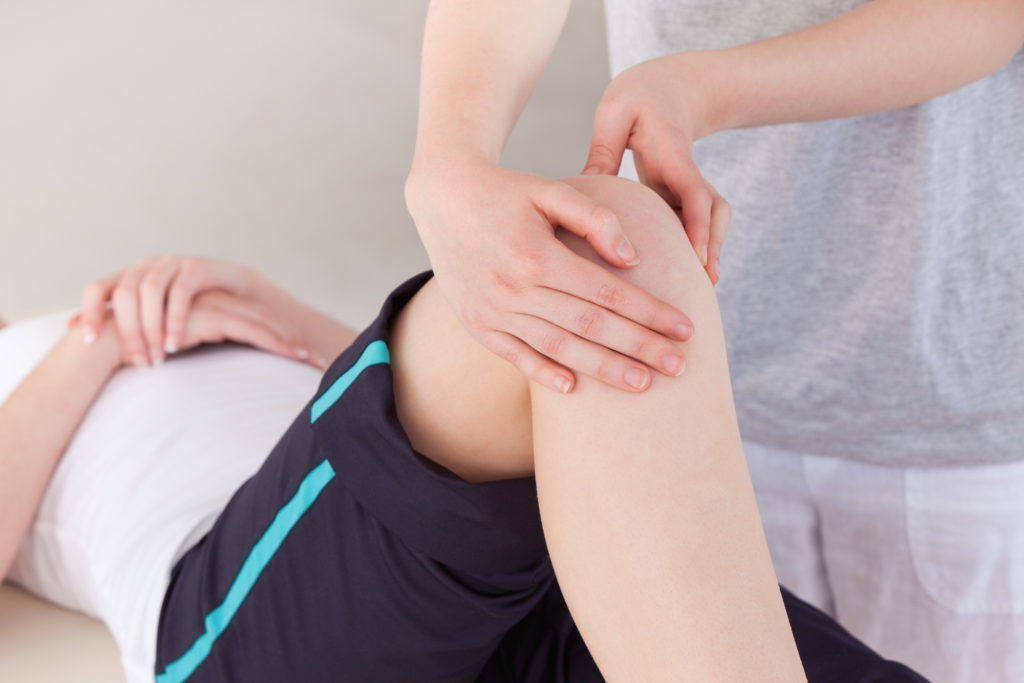
Local preparations in the form of a gel or ointment are endowed with the lowest therapeutic properties. Therefore, they must be used in combination therapy. Active substances are absorbed faster through the surface of the dermis in the affected areas when using creams for therapeutic procedures (phonophoresis).
Intramuscular drug administration
Injections of drugs in this group are the middle of quality therapy for arthrosis of the joints. In this case, the rate, absorption of active substances in the metabolism of intra-articular tissue is slightly higher than when taking tablets. This feature is useful for patients with a combination of two diseases - arthrosis and gonarthrosis, osteochondrosis. After therapy, it is advisable to switch to the use of supportive care.
Chondroprotectors for intramuscular and intra-articular administration have excellent capabilities.
Intra-articular effective injections
 Most efficient way prevent the rapid destruction of intra-articular cartilage, restore it - introduction medicinal product into the focus of inflammation. In this manipulation, in addition to positive characteristics, there are certain limitations. This is due to the process of the treatment procedure, possible complications... Therefore, the need to prescribe therapy is determined by the attending physician who will carry out this procedure.
Most efficient way prevent the rapid destruction of intra-articular cartilage, restore it - introduction medicinal product into the focus of inflammation. In this manipulation, in addition to positive characteristics, there are certain limitations. This is due to the process of the treatment procedure, possible complications... Therefore, the need to prescribe therapy is determined by the attending physician who will carry out this procedure.
The knee joint can be felt without much difficulty, since it is a fairly large organ. With inflammation of the cartilage tissue, various drugs are injected into it, which are used for intramuscular injection("Don", "Mukosat", "Alfutol") and analogs of intra-articular normal fluid based on effective hyaluric acid.
Medicines of this group are quite expensive, which somewhat limits their use. Most patients with gonarthrosis use them only in exceptional cases, with advanced forms of the disease, when really effective remedies are needed for treatment. Adding analogs to the joint synovial fluid in the last stages of the disease, a really high result was noted. The duration of therapy is 3-5 injections.
Chondroprotectors are drugs that occupy a special place in complex therapy for the treatment of arthrosis of any form. It is not necessary to expect an anesthetic immediate result from the medicines of this group, since they protect the joints, slowing down the process of destruction of the intra-articular tissue, gradually restoring the damaged structure.
Gonarthrosis (arthrosis of the knee joint) is a rather complex ailment that cannot always be eliminated.
The success of therapy will depend on many factors, for example, the age of the patient, the degree of neglect of the disease, concomitant health problems and, of course, the chosen treatment tactics and medications.
So, at the moment, pharmacology and pharmacy chains offer medicines of various spectrum of action. They can be divided into several groups.
Anti-inflammatory drugs
It is with NSAIDs (non-steroidal anti-inflammatory drugs) that often begins to help with arthrosis of the knee joint. This should include drugs: Sulindak, Aspirin (acetylsalicylic acid), Meloxicam, Lornoxicam, Nabumeton, Nimesulide, Phenylbutazone, Diclofenac, Indomethacin, Ibuprofen, Celecoxib, Piroxicam, Etodolac, Aceclofiburofen
Such drugs differ from each other not only by the strength of the effect on the patient's body, but also by the likelihood of developing negative undesirable effects.
- Diclofenac;
- Ketoprofen;
- Indomethacin.
Least of all, Aspirin, Amidopyrine, Ibuprofen will help to relieve pain. However, due to the fact that each organism reacts to drugs in its own way, the effectiveness of these funds may differ significantly from that stated in either direction.
As for the removal of inflammation, Indomethacin, Diclofenac and Flurbiprofen will be stronger. Less benefit in this regard will bring the body:
- Ibuprofen;
- Aspirin;
- Naproxen.
Every person suffering from knee pathology should know that drug treatment of knee arthrosis with NSAIDs has many side effects... It can even be dangerous with prolonged use of such drugs. Therefore, doctors recommend them to their patients in short courses and in small dosages (if possible).
In addition, such drugs significantly increase the risk of developing erosive diseases of the gastric mucosa. Especially carefully treat arthrosis with NSAIDs for gastritis, gastric ulcer and 12 duodenal ulcer. However, to date, new generation NSAIDs have been synthesized. They do not affect the gastrointestinal tract, not as harmful as their predecessors.
Anti-inflammatory drugs reduce the rate of blood flow in the kidneys and retain sodium and water in the body.
This causes jumps in blood pressure levels and the development of kidney failure. Still drugs in this group have a negative effect on blood clotting. With uncontrolled use, it may develop:
- thrombosis;
- stroke;
- myocardial infarction.
Chondroprotectors
This includes capsules of drugs that help protect cartilage and stimulate their formation in the joints. Unlike NSAIDs, chondroprotectors not only eliminate the signs of pathology, but also qualitatively affect its root cause. Drugs in this group are the most important drugs in the treatment of gonarthrosis. They contain the active ingredients glucosamine and chondroitin sulfate. These active substances can be included in preparations in various combinations:
- Arthra. Combined agent, which contains the same amount of chondroitin and glucosamine (500 mg each);
- Teraflex. The capsules contain 500 mg of glucosamine and 400 mg of chondroitin. Take the drug depending on the stage of the pathology, 2-3 capsules per day;
- ... Means only based on glucosamine. It is made in the form of a sachet (a sachet of powder for oral administration) and ampoules (for intramuscular administration). For the maximum result of therapy, it is recommended to combine injections with oral administration;
- Chondrolone. Monopreparation of Russian production based on chondroitin sulfate. It is produced in the form of dry powder in ampoules. For intramuscular administration, it should be dissolved in water. One ampoule contains 100 mg of the substance. Chondrolone is administered (with excellent tolerance) in 1 or 2 ampoules every other day. The course will be 25-30 injections;
- Structum is a monopreparation of chondroitin sulfate (dosage 250 or 500 ml). He is prescribed 2 capsules per day (500 mg) or 4 (250 mg);
- Elbona is a Russian drug based on glucosamine sulfate. It is produced in ampoules of 2 ml for intramuscular injection. Active ingredient in an ampoule 400 mg;
- Chondroitin AKOS is a domestically produced chondroprotector containing chondroitin 250 mg per capsule;
- Chondroxide. This drug is offered in capsules of 250 mg of chondroitin each and 5% ointment. To obtain the expected therapeutic effect, the volume active substance a day should be at least 1000 mg (4 capsules or tablets).
If you treat arthrosis of the knee joint with chondroprotectors, then you should pay attention that these drugs are slow-acting. In other words, the effect of their use develops slowly and makes itself felt only after 5 months. The course of treatment is from six months to a year.
Moreover, they work only in the early stages of pathology (1 and 2), and at 3 stages of arthrosis, chondroprotectors are meaningless, because by this moment the cartilaginous tissue is completely destroyed and there is nothing to restore.
Preparations for intra-articular administration
A good treatment result can be obtained not only due to the oral and intramuscular use of the prescribed funds, but also intra-articular (injection of the drug directly into the joint cavity).
Thanks to this method, the drug can enter the focus of pathology and the synovial fluid, through which the cartilage tissue is nourished.
Often, the doctor will treat the patient with corticosteroid anti-inflammatory hormones, for example:
- Hydrocortisone. Relieves inflammation, has anti-shock and anti-allergic effects. Available in 2 ml ampoules;
- Kenalog. The active ingredient triamcinolone has an immunosuppressive, anti-allergic and anti-inflammatory effect. For the treatment of the knee joint, 20-40 mg of the drug is used;
- Celeston - solution for injection in ampoules of 4 ml;
- Flosterone is a combined prolonged-release corticosteroid based on betamethasone (1 ml contains 2 mg of disodium salt and 5 mg of betamethasone dipropionate).
- Diprospan is a suspension for injection in ampoules. The active ingredient is betamethasone.
The presented drugs should be injected exactly inside the joint, because their analogs in tablets can adversely affect the digestive organs, they are especially dangerous for people who have a predisposition to pathologies of the gastrointestinal tract. allow the drug to quickly and efficiently relieve pain and inflammation, making the patient feel better.
Also recently, treatment has become popular with the introduction of hyaluronic acid, a substance called sodium hyaluron, into the joint. This tool has a different name - "liquid prosthesis". The acid acts as the synovial fluid by creating an additional protective layer in the knee that improves movement.
It helps to reduce joint injury during physical activity by moisturizing the cartilage and improving its nutrition.
Hyaluron can be purchased in the form of drugs:
- Ostenil;
- Synvisc;
- Dyuralan;
- Fermatron.
The therapeutic effect of them is usually good, however, not every of our compatriots can afford such a method of treatment due to the high cost of the medicine.
The treatment course is 3-4 injections into each knee joint, and you need to inject once a week.
Topical preparations
Positive dynamics in gonarthrosis can be achieved by using topical medications. Often, doctors recommend to their patients Espol, Fastum-gel, Voltaren-gel, indomethacin, butadion ointment, Menovazin, Nikoflex-cream, Diclofenac and some others.
On their own, they are not able to provide a significant therapeutic effect because through skin covering only 4 to 8% of the active substance appears to the focus of inflammation.
Therefore, therapy with creams and ointments should be supplemented with anti-inflammatory and analgesic drugs orally, intra-articularly, intramuscularly.
You can prepare medical compresses based on drugs for external use. These include:
- Bischofite (a derivative of petroleum products that has a beneficial effect on arthrosis);
- Dimexide (an analgesic agent that penetrates well through the skin and relieves inflammation);
- medical bile (characterized by excellent resorption and warming properties).
It should be noted separately that drugs alone are not enough to maintain well-being and control knee arthrosis. They should be combined with physiotherapy, spa treatments and traditional medicine recipes (if there are no contraindications).
In our time, you need to move quickly in order to do everything. It is rare to see people walking slowly. After all, in the morning to work, then home, there is also a lot of things to do. And so almost every day. And from this running, the legs most often suffer. We rarely go to the doctor right away, we usually go to the pharmacy and buy pain relievers.
Nowadays, pharmacies have such a large assortment of drugs that you can get confused in some names. And for what they are intended and from what they help, there is not always time to read the leaflet. But self-medication rarely helps, especially if you develop arthrosis of the knee joint.
When should you see a doctor?
Everyone should understand the importance of the fact that with timely access to a doctor, arthrosis of the knee joint can be stopped and cured.
What is knee arthrosis? It is a chronic disease in which cartilage tissue is destroyed.
Here are the signs, if you have at least one or two, urgently contact a rheumatologist for a check:
- Crunching knee when moving;
- Stiffness in the joint;
- Painful sensations when walking in the knee joint;
- Swelling of the knee;
- The joint gets tired faster.
The doctor, after examining and determining the stage of development of the disease, prescribes a comprehensive treatment. Let us consider in more detail what drugs are recommended for arthrosis of the knee joint.
Attention! Only your doctor should prescribe medications for you!
Non-steroidal anti-inflammatory drugs (NSAIDs).
They act not only on the inflammatory processes that occur in the knee joint, these drugs also have an analgesic effect. But they have a number of contraindications, so you need to drink them very carefully.
1) Ointments and gels. They effectively relieve pain and inflammation in the first stage of arthrosis. And they have no side effects.
Diklak-gel 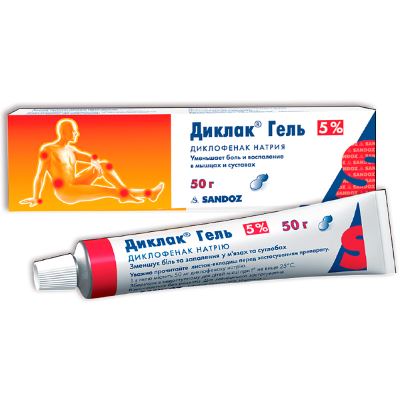
Ingredients: diclofenac sodium - a derivative of phenylacetic acid. Excipients.
Indications: relieves swelling, inflammation, pain during rheumatic processes in soft tissues, injuries, joint diseases. Effective for arthrosis and arthritis of any location (knee, ankle, etc.).
Application: Apply a thin layer to problem areas.
Duration of use: 10-14 days, 3-4 times a day.
Voltaren-Emulgel 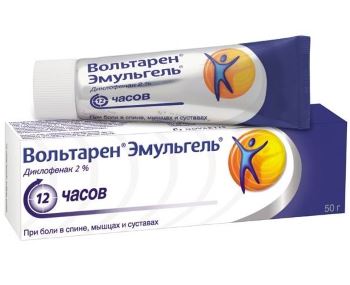
Ingredients: diclofenac diethylamine. Excipients.
Indication: eliminates pain symptoms and swelling during inflammation. Effective for diseases of joints and muscles, incl. arthrosis of the knee joint.
Application: The required amount depends on the area to be treated. It is necessary to apply little by little, gently rubbing the medicine.
Duration of use: 2 weeks, 3-4 times a day.
Ibuprofen 
Ingredients: ibuprofen. Excipients.
Indications: Radiculitis, rheumatism, trauma, myalgia, lumbago, arthritis and arthrosis of any location (knee, shoulder, ankle, etc.).
Application: a small amount of the medicine is applied, rubbing in with light movements until completely absorbed. It is necessary to apply to the affected area at intervals of 4 hours no more than four times a day.
Duration of use: 2-3 weeks.
2) Non-steroidal anti-inflammatory non-selective agents. The method of using the tablets is simple, but it is necessary to take into account the side effects that can be caused by ingestion on the gastrointestinal tract. After all, few people want to get rid of arthrosis of the knee joint, to earn a stomach ulcer.
Diclofenac (Voltaren)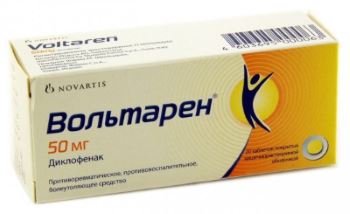
Ingredients: diclofenac sodium, excipients.
Indications: inflammatory, degenerative pathological processes in the musculoskeletal system. Reduces temperature, pronounced anti-inflammatory effect, analgesic effect.
Application: The individual dosage of the medicine is selected. 25-50 mg is taken orally 2-3 times a day.
Duration of use: At the discretion of the attending physician.
Indomethacin 
Ingredients: indomethacin. Excipients.
Indications: Expressed anti-inflammatory, analgesic and antipyretic effects. Helps with inflammatory, degenerative diseases of the joint (arthrosis of the knee joint, arthritis, etc.), periarticular diseases, etc.
Application: The medicine is prescribed by the attending physician. He also sets the dose and duration of admission. The initial dose is 25-50 mg 2-4 times a day. The maximum dosage is 200 mg per day.
3) Anti-inflammatory nonsteroidal drugs (coxibs). This subgroup of drugs has been developed specifically to treat the symptoms of arthrosis. But these drugs also have side effects. They have a detrimental effect on the heart, kidneys, liver. If there are serious diseases of these organs, these drugs are strictly prohibited for use. You also need to monitor compatibility with other medications.
Rofika
Ingredients: rofecoxib. Excipients.
Indications: treatment of symptoms of arthrosis of the knee joint and other locations, primary dysmenorrhea.
Application: Individual prescription of the drug. Treatment with the first courses is 4-6 weeks. The minimum is 12.5 mg, the maximum dose per day is 25 mg.
Celebrex 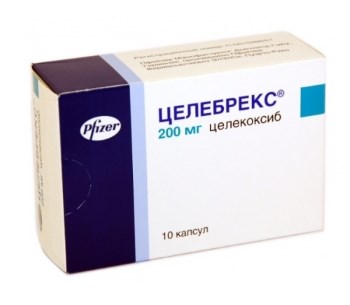
Ingredients: celecoxib. Excipients.
Indications: Treatment of symptoms of arthritis and osteoarthritis (including arthrosis of the knee joint). It can be used in children from 2 years of age (body weight 10 kg or more) to relieve the symptoms of juvenile idiopathic arthritis.
Nimulid
Composition: nimesulide. Excipients. 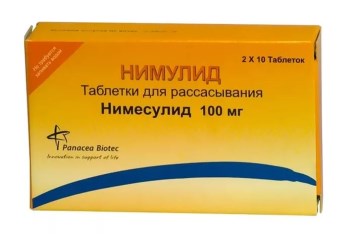
Indications: Treatment of pain in diseases of joints, muscles and bone tissues, including arthrosis of the knee joint, arthritis, myalgia, etc. Pain reliever for injuries, diseases of the ENT organs, the postoperative period in dentistry and gynecology.
Application: Prescribing the medication individually. Usually appoint 100 mg 2 times a day. The maximum is 400 mg.
4) NSAIDs administered intramuscularly. They have no gastrointestinal side effects. Thus, older people or those who are not allowed to take these medications by mouth can be treated.
Melksikam (movalis, arthrosan)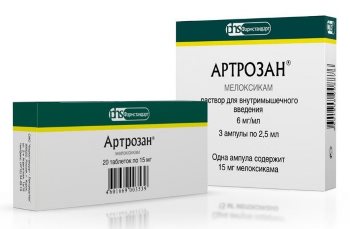
Ingredients: meloxicam. Excipients.
Indications: short-term therapy of symptoms of arthritis, arthrosis, ankylosing spondylitis.
Applications: Intramuscular injections should be done in the first 2-3 days. Then switch to other dosage forms.
Glucocorticosteroids.
If arthrosis of the knee joint is complicated by synovitis, or NSAIDs do not effectively cope with treatment, the attending doctor prescribes intra-articular injections of corticosteroid drugs.
But you should know that these drugs do not cure arthrosis, but only stop the symptoms: reduce swelling, remove pain, reduce inflammation.
Kenalog 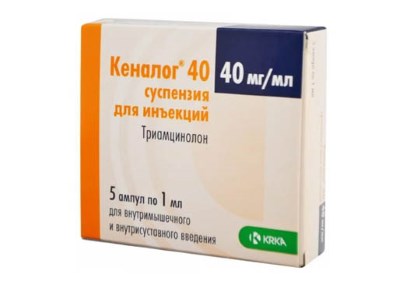
Composition: Triamcinolone acetonide, excipients.
Indications: it is administered intra-articularly for dysfunctions of the joint capsule, joint dropsy, arthritis and arthrosis of any location. (Knee, elbow, ankle, etc.)
Application: 10-40 mg to 80 mg is injected into the diseased joint. Re-introduction if necessary after 3-4 weeks.
Celeston 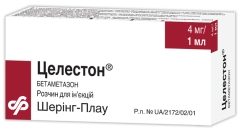
Composition: betamethasone, excipients.
Indication: It has a positive effect on the treatment of arthritis and osteoarthritis (including knee, shoulder, etc.).
Application: individual prescription of the drug. Single dose: 0.4-6 mg.
Chondroprotectors.
It is safe to say that chondroprotectors are a cure for arthrosis of the knee joint.
After all, these drugs act on the very cause of the appearance of arthrosis - the destruction of cartilage tissue. They help to strengthen and repair cartilage.
Two substances are involved in this process: chondroitin sulfate and glucosamine.
These medicines may contain one of these substances or be combined.
Combined chondroprotective drugs are more effective.
Combined medicines.
Terafrex 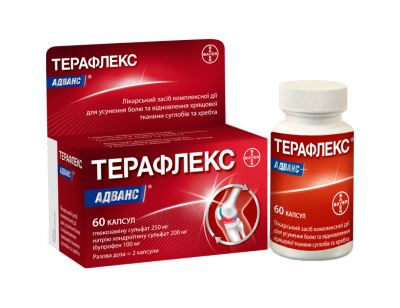
Capsule composition: glucosamine - 500 mg, chondroitin sulfate - 400 mg, excipients.
Indications: Degenerative-dystrophic diseases of the joints and spine, stage 1-3 osteoarthritis, osteochondrosis.
Application: first 21 days, 1 capsule 3 times a day, then 1 capsule - 2 times a day. Reception should be long-term from 2 to 3 months. Then a second course with an interval of 3 months.
Artra 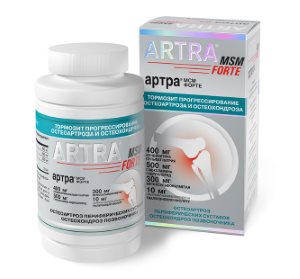
Capsule composition: glucosamine - 500 mg, chondroitin sulfate - 500 mg, excipients.
Indications: arthrosis of the peripheral joints and spine. It is irreplaceable in the treatment of diseases associated with the destruction of cartilage tissue.
Application: 1 tablet daily for 6 months.
Mono-drugs.
Don 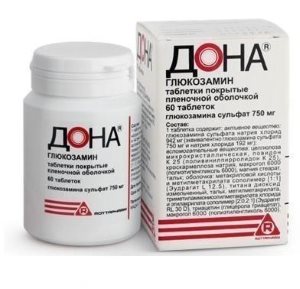
The medicine is available in the form of a powder, a solution for intramuscular injection.
Ingredients: glucosamine sulfate, excipients.
Indications: prevention and treatment of arthrosis of any localization (hip, knee, etc.), periarthritis, patellar chondromalacia. It has an analgesic effect and normalizes metabolic processes in the joint.
Application: powder: dilute 1 sachet with water, take once a day.
Solution: Ampoule A is mixed with ampoule B. Intramuscular injection 3 ml 3 times a week.
Hondrolone 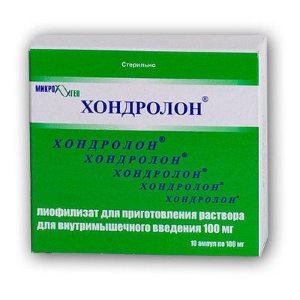
Ampoule composition: chondroitin sulfate, excipients.
Indications: Degenerative diseases of the joints and spine. It has an analgesic effect and improves the mobility of the joint.
Application: by dissolving the powder in 1 ml of water for injection, inject intramuscularly. The course is 25-30 injections. Prescribed medicine.
Joint fluid prostheses.
Hyaluronic acid drugs, when injected intra-articularly, act on the cartilage: restoring it, providing easier sliding of the knee joint. Hyaluronic acid acts as a synovial fluid to protect cartilage. If you enter correctly, there are almost no side effects. It is an almost ideal remedy for arthrosis of the knee joint. The only negative is its cost.
Fermaton 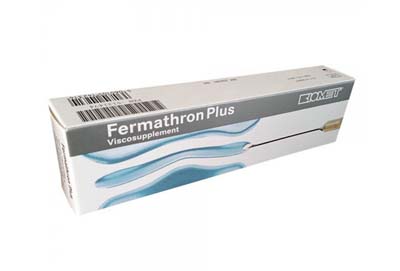
Ingredients: sodium hyaluronate.
Indication: Pain relieves and improves the mobility of the knee joint and other joints in which synovial fluid is present in patients with varying degrees of osteoarthritis.
Application: The medicine is administered by a trained healthcare professional. 1 to 3 injections are injected into the joint cavity once a week.
Ostenil 
Ingredients: sodium hyaluronate, excipients.
Indications: Degenerative and traumatic changes in the knee, hip or other synovial joint, which are accompanied by pain and limitation of motor function.
Application: once a week for 3-5 weeks. If necessary, repeat the course after 6 months.
Dyuralan 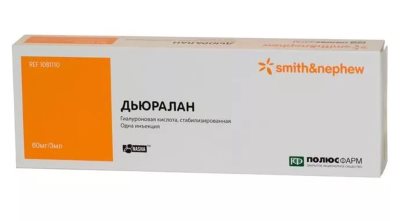
Ingredients: Non-animal hyaluronic acid, stabilized. Excipient: 0.9% sodium chloride solution.
Indication: Treatment of symptoms of arthrosis of the knee or hip joint.
Application: 1 injection into the joint.
Summarizing
We must not forget that a joint is an interaction not only of bones, but also of muscles with ligaments. Therefore, for effective treatment, it is necessary to take not only drugs. With arthrosis of the knee joint, you need to observe the orthopedic regime, as well as constantly attend physiotherapy, massage. If necessary, adjust the weight and your menu by adding more grains and fruits.
In addition, medications must be taken continuously and preferably at the same time. This is the only way to achieve a positive effect.
Can be used traditional medicine... There will be no harm from it, only a consultation with a doctor is required first. But the benefits can be tangible, because if you put a warming compress, the blood will circulate faster, which means that the drugs will get into the joint faster.
Arthrosis of the knee joint (gonarthrosis) is a complex disease that does not always respond to treatment. Therefore, in this article, we have prepared for you a list of drugs that are most effective in treating this disease.
Quick navigation through the article:
1st group of drugs: anti-inflammatory drugs
What is the danger of taking NSAIDs?
2nd group of funds: chondroprotectors
What is important to remember when treating with chondroprotectors?
Preparations for intra-articular administration
Topical medications
Warning: all information about the remedies for arthrosis of the knee joint is published for informational purposes only, for personal information. Do not try to use them yourself without consulting a doctor: self-medication can cause irreparable harm to your health!
All medicines for the treatment of osteoarthritis of the knee can be divided into several large groups according to the mechanism of action.
1st group: anti-inflammatory drugs
Aertal is one of the new drugs for gonarthrosis
It is with non-steroidal anti-inflammatory drugs (NSAIDs) that the treatment of osteoarthritis of the knee usually begins.
This group of drugs includes medications such as aspirin (acetylsalicylic acid), phenylbutazone, etodolac, indomethacin, sulindac, ibuprofen, piroxicam, aceclofenac, tenoxicam, diclofenac, lornoxicam, naproxen, rofecoxapuli, nabecinoxymethone ketoxica, flurbiprofen, celecoxib and others.
NSAIDs differ both in strength of action and in the likelihood of developing side effects.
These drugs do not contain anti-inflammatory hormones, but nevertheless, in most cases, they know how to cope well with joint pain and reduce inflammation in them.
So, ketoprofen, diclofenac, indomethacin usually have the greatest analgesic effect, while aspirin, ibuprofen, amidopyrine relieve pain much worse. But since many people may have individual reactions to various medications, their effectiveness of these medications may differ significantly from generally accepted norms - both in one direction and in the other direction.
Side effects
Unfortunately, despite the fact that nonsteroidal anti-inflammatory drugs usually help to effectively relieve pain in osteoarthritis and other diseases, they are not very safe for health and have rather strong side effects. That is why doctors usually prescribe them for not very long courses and, if possible, in small doses.
What is the danger of taking NSAIDs?
a) problems from the gastrointestinal tract, primarily the effect on the gastric mucosa

Taking NSAIDs dramatically increases the likelihood of developing erosions and even ulcers of the gastric mucosa. This is especially true for people who have previously (or currently) such diseases as gastritis and gastric ulcer and duodenum as well as elderly patients.
However, recently, new generation NSAIDs have been synthesized, in which the negative effect on the gastrointestinal tract is significantly reduced.
This group of drugs is called selective COX-2 inhibitors and includes drugs such as nimesulide and celecoxib.
b) side effects from the kidneys
NSAIDs reduce the rate of renal blood flow, and also promote water and sodium retention in the body, which can contribute to high blood pressure, as well as the development of acute heart failure and kidney failure.
c) problems with the heart and blood vessels
Non-steroidal anti-inflammatory drugs, among other things, affect the blood coagulation system. If taken incorrectly, patients can develop vascular thrombosis and even stroke or myocardial infarction. The drugs that are characterized by such an effect include, first of all, the very COX-2 inhibitors, which reduce the risk of developing gastric complications.
Things to Remember While Taking NSAIDs
As you can see, non-steroidal drugs are not at all as harmless as it is commonly believed. That is why you should not prescribe such treatment yourself, but you need to consult a doctor who will select the drug that is suitable for you and its dose.
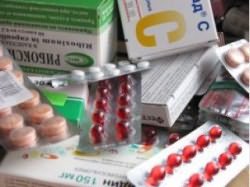
If there is a need to take painkillers for arthrosis of the knee joint for a long time, it is better to use drugs of other groups for this, which, when taken for a long time, do not give such harmful side effects and have a large selective (selective) effect without negatively affecting the gastric, renal or cardiovascular systems.
For these purposes, drugs such as Movalis are more suitable, which can be taken in long courses - from several weeks to several months or more - but, of course, also only under the supervision of a doctor.
In addition, taking NSAIDs is fraught with the fact that it "obscures" the symptoms of arthrosis: as you know, pain is a signal from the body that something is wrong in it. If the pain is completely relieved by taking these drugs, then there is a high probability that a person with such a disease will give up on the disease, relax and do nothing to recover, except for taking pain medications.
This approach is very dangerous, because, despite the absence of pain, the disease continues to progress, the cartilage tissue continues to deteriorate, and a person may think that everything is in order with his health and he has nothing to worry about.
In fact, the correct approach to taking NSAIDs should be as follows: it is necessary to take these medications as prescribed by a doctor, but not in order to forget about the disease, but in order to create an opportunity to undergo complex treatment without pain in the joints: take other medications that are necessary for the treatment of osteoarthritis, undergo the necessary physiotherapy procedures, massage courses and others therapeutic measures that would be impossible to exercise in the presence of pain.
2nd group of funds: chondroprotectors
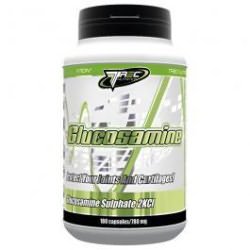
chondroprotectors - the most important drugs for arthrosis of the joints
Chondroprotectors (CP) are drugs that help protect cartilage tissue and enhance its formation (synthesis) in the joints.
Unlike anti-inflammatory drugs, CP not only removes the symptoms of arthrosis of the knee joint, but also affects the very cause of osteoarthritis - it helps to improve the nutrition of cartilage tissue and its restoration. In this sense, chondroprotectors are one of the most important drugs for the treatment of this disease.
This group of agents includes such active substances as chondroitin sulfate and glucosamine. They can, in different combinations, be part of various drugs - such as Dona, Terafrex, Artra, Structum, Chondroxide, Elbona, Chondroitin Akos, Chondrolone, Zinaxin, Artrin and others.
Artra
Artra is a combined preparation containing equally both glucosamine and chondroitin sulfate (500 mg each in one capsule). The drug is produced by the American company Unipharm, the cost of one package, depending on the number of capsules, costs from 500 to 1700 rubles. Artra is considered one of the best chondroprotectors at the moment.
Teraflex
This medicine is also combined: one of its capsules contains 500 mg of glucosamine and 400 mg of chondroitin sulfate, and is produced by the German company Bayer. Teraflex is taken, depending on the stage of the disease, 2-3 capsules per day. It costs, depending on the number of tablets, from 600 rubles (for a package of 30 capsules) to 1500 (120 capsules) and more.
Don
Dona contains only glucosamine. Don is produced in the form of sachets (sachets of powders for oral administration), capsules, as well as ampoules for intramuscular administration. For the most effective treatment, manufacturers recommend combining oral administration with intramuscular injections.
This medicine is produced by the Rottapharm company and its price ranges from 1000 to 1300 rubles - both for capsules and sachets and for ampoules.
Hondrolone

This is a mono-drug of chondroitin sulfate, which is produced by the Russian pharmaceutical company Microgen. It is produced in the form of a dry substance in ampoules for dilution and subsequent intramuscular administration.
One ampoule, which must be diluted in 1 ml of water, contains 100 mg of the active substance. Chondrolone is administered in 1 or 2 (with good tolerance) ampoules every other day with a course of 25-30 injections. Its price at the beginning of 2013 ranges from 1000 to 1200 rubles for a pack of 10 ampoules.
Structum
Structum is also a mono-drug that contains chondroitin sulfate in an amount of 250 and 500 mg. Produced by Pierre Fabre Medicament Productions (France).
It is prescribed at a dose of 1000 mg per day, i.e. you need to take 2 capsules a day, 500 mg each, or four - about 250 mg. A package with 60 capsules of this chondroprotector will cost you 1200-1300 rubles.
Elbona
Elbona is a Russian remedy that contains only glucosamine sulfate. This medicine is produced in 2 ml ampoules (plus 1 ml ampoule with a solvent) for intramuscular administration; one ampoule contains 400 mg of active ingredient.
Chondroitin AKOS
As the name suggests, this CP is also a mono-drug containing chondroitin sulfate in an amount of 250 mg of active ingredient in one capsule. This medicine, like the previous one, is produced in Russia.
Chondroxide

chondroxide ointment for joints
This medicine contains only one active ingredient - chondroitin sulfate, however, it is produced not only in the form of capsules (250 mg each), but also in the form of a 5% ointment. It is produced by the Russian pharmaceutical company Nizhpharm.
For a therapeutic effect, the dose of this drug, like other representatives of this group, should be 1000 mg of active ingredient per day, i.e. 4 capsules a day.
A package of 60 capsules will cost 400-500 rubles. The ointment in a 30 gram tube will cost from 250 to 300 rubles ().
What is important to remember for the patient during treatment with chondroprotectors?
- first of all, chondroprotective drugs are slow-acting drugs. This means that the effect of treatment develops very slowly, and it can be seen only after 3-5 months, and the course of treatment with these drugs is from 6 to 12 months and sometimes more; please be patient.
- CP work only in the early stages of arthrosis - at 1 and 2 degrees; at the 3rd degree of this disease, it makes no sense to take chondroprotectors, since on it all the cartilaginous tissue of the joint has already been destroyed and there is simply nothing to recover there.
- There is no general agreement among doctors now about whether it is worth taking glucosamine and chondroitin sulfate together or separately. There are studies that suggest that when these two substances are administered together, they can weaken the action of each other. But while this question remains open, it is better to leave it to the discretion of your doctor and, if possible, give preference to the products of large, reliable pharmaceutical companies with high quality products.
Medications for intra-articular administration (injections into the joint)
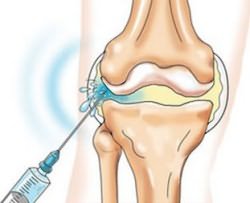
In addition to drugs administered orally and intramuscularly, a great therapeutic effect in osteoarthritis is provided by the introduction of various drugs directly into the joint cavity (intra-articular injections). Thanks to this method of administration, drugs directly enter the area of exposure - into the synovial fluid, through which the cartilage tissue is fed.
Most often, corticosteroid anti-inflammatory hormones are used for injection into the joint: hydrocortisone, kenalog, celeston, diprospan, phlosterone and others. These drugs are injected inside the joint, because when taken in pills, such drugs have a lot of side effects. But when injected directly into the joint, they very quickly and effectively reduce pain and inflammation in the joint, making the patient's condition easier.
An important point: corticosteroids, like NSAIDs, do not treat osteoarthritis, but only have anti-inflammatory and analgesic effects. In order to truly treat this disease, it is necessary to use other drugs - the same chondroprotectors.
Also, in recent years, a method of treatment has been used such as intra-articular administration of hyaluronic acid (sodium hyalorunate). This remedy acts on the joint as a "liquid prosthesis" or additional synovial fluid, which creates a protective layer in the joint that improves movement in the joint, helps to reduce trauma to the joint during movement, moisturizes the cartilage tissue and improves its nutrition.
Sodium hyaluronate is available in the form of drugs such as fermatron, dyuralan, ostenil, synvisc. The therapeutic effect of the introduction of these medicines is usually very good, but, unfortunately, not everyone can afford such treatment.
So, one dose of fermatron for intra-articular injection will cost 3500-4000 rubles, while the treatment course is 3-4 injections 1 time per week into each diseased joint. Therefore, the high price is the only factor holding back the development of this method of treatment.
Topical medications
Good healing effect with gonarthrosis, various medications applied topically are also provided.
So, as therapeutic ointments and gels for topical use, such ointments as Fastum-gel, indomethacin and butadion ointments, Menovazin, Voltaren-gel, Nikoflex-cream, Espol, diclofenac-ointment and many others have shown themselves well.
They have a good therapeutic effect, but it is important to remember that only 4 to 8% of the drug passes through the skin to the "destination" - the diseased joint, therefore, anti-inflammatory and analgesic treatment with ointments, creams and gels almost always needs to be supplemented with drugs. taken orally or intramuscularly.
For the preparation of medical compresses, you can use various medicinal substances for external use. These include, for example, bischofite (an oil derivative that has a beneficial effect on arthrosis), Dimexide (an anti-inflammatory and analgesic drug that penetrates well through the skin), as well as medical bile, which has good warming and absorbing properties.
However, in order to keep under control such a complex disease as arthrosis of the knee joints, sometimes it is not enough just to take drugs in one form or another.
Drug treatment must be combined with physiotherapy procedures for arthrosis of the joints, spa treatment, and if your doctor does not mind, you can use effective folk recipes treatment of gonarthrosis.
And remember: it is dangerous to self-medicate for effective treatment of arthrosis of the knee joint. If you experience joint pain, be sure to consult a doctor!
Knee arthrosis: treatment and prevention
Arthrosis of the knee joint (gonarthrosis) is a disease that over time causes irreversible changes in the cartilage, leading to its gradual destruction due to circulatory disorders and the occurrence of degenerative processes in the joint. Timely drug treatment, physiotherapy, massage and gymnastics can slow down the development of gonarthrosis.
How the knee joint works and its function
To understand how and how to treat gonarthrosis, it is necessary to recall a little the main features of the knee functioning. This joint is formed by the articular surfaces of the femur and tibia, which are covered with hyaline cartilage. To ensure the congruence of the surfaces in the joint, medial and lateral menisci are provided. In addition, the knee is reinforced with ligaments (some of them pass in the joint cavity) and a periarticular bag.
Inside the knee is synovial fluid that lubricates the joint, nourishes the cartilage surface and prevents the joint surfaces from rubbing against each other. The structural features of the joint are such that only 2 types of movements are performed in it: extension and flexion of the knee, and also, if the leg is bent at the knee, rotation around the axis. The knee joint is one of the largest joints in the body, and it is on it that the main load falls when a person is standing. It increases significantly with heavy lifting, being overweight, jumping and running.
The causes of arthrosis
There is primary and secondary gonarthrosis. The primary form of this disease develops due to abnormalities of the femur or tibia, ligaments or joint surfaces. In this case, the knee experiences severe overloads, which provoke the destruction of the cartilage.
The secondary form is caused by injuries and diseases of the knee. Its main reasons are:
- traumatic knee injuries - ligament ruptures, dislocations, bone fractures, etc.;
- removal of the meniscus - the wear of the hyaline cartilage increases;
- excessive stress on the joint in athletes and people involved in certain types professional activity or are overweight.
- inflammatory diseases of the knee joint - arthritis. Long-term arthritis also leads to malnutrition of the cartilage and over time can be complicated by arthrosis;
- metabolic diseases that lead to the deposition of salts in the joint;
- diseases of the nervous system or blood vessels, as a result of which the innervation and nutrition of the knee joint can be disrupted.
Depending on the cause, arthrosis can develop in one or both knees. A one-sided process most often occurs as a result of injuries, operations, and a two-way process - with excess body weight.
What happens in the joint with gonarthrosis?
Violation of the blood circulation of the joint due to vasospasm or other reasons leads to impaired microcirculation and hypoxia of the cartilage tissue, which is accompanied by the gradual death of the elements of the cartilage and its destruction. If the degenerative process affects the synovium, then it begins to produce only a small amount of intra-articular fluid, there is "dry knee". The particles of destroyed cartilage located in the joint cause reactive inflammation of other elements of the cartilage and promote the release of liposomal enzymes, which further dissolve and destroy the intra-articular surfaces.
Symptoms of gonarthrosis
- Initial stage. From time to time, a person is worried about knee pain, especially if you need to go up or down stairs, get out of bed after sleep. It has been observed for several years.
- Second stage. Painful sensations and crunching occur when making any movements. The X-ray shows signs of incipient degeneration of the articular surfaces. The range of motion in the joint is somewhat reduced.
- Third stage. The pain does not go away even at rest, the joints can no longer bend or unbend to the end, as a result of which there is a change in gait: it becomes "in a flare-up". There is an O- or X-shaped deformity of the knee joints.
Which doctor treats gonarthrosis?
It depends on the stage of the disease and the intensity of the pain syndrome. For example, a patient may be referred to an orthopedic traumatologist, rheumatologist, and in milder cases of arthrosis, even to a general practitioner or family doctor. In any situation, the treatment of arthrosis of the knee joint at all stages of the disease should be complex and individually selected.
How is knee arthrosis treated?
The specific scope of treatment depends on the stage and severity of gonarthrosis. In any case, its goal is to achieve a stable and long-term remission, and in the early stages, to completely cure it by eliminating the influence of the causes that caused it (for example, by normalizing body weight).
The main goals of knee arthrosis treatment are:
- eliminate pain;
- provide cartilage with nutrients, slowing down or completely stopping its destruction;
- increase the range of motion in the joint.
Drug treatment
To reduce the painful attack, eliminate reactive inflammation and relieve exacerbation, hormonal and non-steroidal anti-inflammatory drugs (injections, tablets, ointments) are used - diclofenac, indomethacin, ibuprofen or new generation NSAIDs (Movalis, Xefocam).
Chondroprotectors (chondrothin, don, mucosat) help to normalize the nutrition of the cartilage and prevent its further destruction. However, they do not relieve pain, so patients are not always sure if they are helping. In fact, these drugs are included in the basic therapy for joint diseases, because they create a fertile ground for the restoration of cartilage and its protection from new damage. In addition, intra-articular fluid substitutes and lysosomal membrane stabilizers are used. If necessary, joint blockade can be performed. To improve blood circulation with arthrosis, tablet forms or injections of no-shpa and other antispasmodics are prescribed.
Physiotherapy and remedial gymnastics
In terms of the effectiveness of the effect, physiotherapeutic agents and exercise therapy without exacerbation are the best medicine for arthrosis. Of the physiotherapy procedures, the following are commonly used:
- laser therapy;
- electrophoresis of medicinal solutions;
- magnetotherapy;
- inductotherapy;
- impulsive currents;
- ultrasound;
- paraffin and mud therapy.
At home, it can be warming compresses, self-massage of the knee or contrast baths, which also improve blood circulation. Exercise therapy provides for the implementation of exercises that are performed with minimal stress on the joint. For example, swimming, water aerobics, an exercise bike, and isometric exercises performed primarily while lying or sitting.
X-ray therapy and surgical treatment
X-ray therapy is prescribed for advanced cases of gonarthrosis, severe pain syndrome and ineffectiveness of other treatment methods. If the joint is completely destroyed and cannot perform its functions, it is replaced with an endoprosthesis.
Prophylaxis
In order to prevent exacerbation and further destruction of cartilage, it is necessary:
- a diet that helps to normalize body weight and contains all the trace elements, vitamins and nutrients necessary for cartilage;
- physical exercise. With gonarthrosis, the knee should not be overloaded, therefore running, jumping, prolonged kneeling should be replaced with an exercise bike or cycling, swimming or water aerobics. You should also perform a set of therapeutic exercises daily, which the doctor will recommend;
- comfortable shoes. In this case, stiletto heels or just high unstable heels will also contribute to the progression of gonarthrosis, so it is advisable to refuse this type of footwear.
LechenieSpiny.ru
Gonarthrosis is called arthrosis of the knee joint, which is chronic illness, accompanied by damage to the cartilage of the knee joint with the subsequent development of inflammation and pain that increases with walking.
To date, the world has not yet developed a drug that can completely cure arthrosis of the knee.
There are a number effective methods treatments, the combined use of which helps to significantly slow down the progression of the disease and reduce painful symptoms.
Medicines that relieve pain in arthrosis
This group includes non-steroidal anti-inflammatory drugs: diclofenac, paracetamol, aceclofenac, indomethacin and others. Pain relievers are the mainstay in the treatment of this disease.
It is important to note that drugs of the NSAID group only eliminate joint pain, but they do not have a therapeutic effect and cannot stop the development of the disease.
With prolonged and uncontrolled intake of medications, they can lead to serious side effects, such as gastritis or even an ulcer of the gastric mucosa.
Medical studies have shown that the dose of a drug, for example, diclofenac, is of considerable importance in the treatment of arthrosis of the knee joint. This drug in some doses improves the course of arthrosis, in others - to have a detrimental effect on the cartilage of the joint. Only an experienced doctor can prescribe the dosage regimen that works best for you.
Anti-inflammatory therapy of gonarthrosis
Since the destruction of cartilage is accompanied not only by pain, but also by inflammation of the joint itself (synovitis) with the release of excess fluid into its cavity, it is necessary to take medications that will help the body fight this inflammation. This task is within the power of anti-inflammatory hormones - corticosteroids.
The drugs of this group - kenalog and hydrocortisone, are injected into the knee joint by injection.
This procedure is called intra-articular knee block. It allows not only to reduce inflammation in the joint, but also reduces pain in it, especially in cases where pain relievers from the NSAID group no longer help.
Cartilage repair drugs
Chondroprotectors are drugs, which activate the synthesis of new cartilaginous tissue by cartilage cells (chondrocytes) instead of the decaying one. These drugs, entering the body, deliver the "building material" to the joint for cartilage restoration.
Thanks to this, the destruction of the cartilage of the knee joint slows down, its condition improves, and along the way - the pain in the joint decreases.
This group of drugs includes: glucosamine sulfate, chondroitin sulfate, hyaluronic acid.
If the use of chondroprotectors began in the early stages of the disease and according to the doctor's recommendations, then, as a rule, a long course of such therapy helps to significantly improve the condition of the cartilage of the joints and slow down the development of arthrosis.
How to treat arthrosis of the knee joint - non-drug methods of therapy
Physiotherapy treatment of gonarthrosis is quite quick and effective way within a relatively short period of time, improve the condition of the affected joint and reduce the manifestations of pain. Combining physical therapy with medication can help reduce the dose of pain relievers used.
Infrared laser therapy, ultrasound therapy, radon and hydrogen sulphide baths, high-frequency magnetotherapy have the best therapeutic effect for arthrosis. Such physiotherapy procedures, in addition to relieving pain, have a general strengthening effect on the body, help to improve mood and reduce stress levels.
Physiotherapy for arthrosis has certain indications and contraindications. The procedures are usually carried out only for arthrosis of 1 or 2 degrees, during periods when there is no active inflammation.
With an initial and moderate degree of knee gonarthrosis, a spa treatment is recommended, which includes mud therapy (peloid therapy), all kinds of therapeutic baths and other physical effects.
Resorts where mud therapy is carried out and there are hydrogen sulfide waters are located in Pyatigorsk, Archman, Bakirovo. Sanatoriums with chloride and sodium mineral waters are located in Svetlogorsk, Pyatigorsk, Odessa, Evpatoria, Lipetsk.
You can go to such a resort only in the absence of exacerbation.
Attending physical therapy classes and manual therapy sessions will significantly improve the patient's condition with arthrosis of the knee.
Thanks to dosed physical activity and the implementation of certain exercises, it is possible to reduce excessive stress on the joints and eliminate overstrain of the ligaments and muscles when the normal trajectory of movement in the joint begins to change.
Surgical treatment of arthrosis
In the treatment of grade 3 gonarthrosis of the knee joint, only a few medications can help, therefore, at this stage of the disease, only surgery... This includes joint replacement and arthroscopic debridement.
Arthroscopic debridement is performed only at an early stage of osteoarthritis. During the procedure, the surgeon uses an arthroscope to remove small pieces of broken cartilage that cause pain from the joint. This manipulation helps to reduce pain for several years.
Arthroplasty is an operation in which a joint is replaced with a new, artificial one made of metal, plastic or ceramic. Joint prostheses have a long service life (about 20-25 years), such an operation allows you to fully restore movement in the joint and eliminate pain.
Medical treatment of arthrosis of the knee joint
Treatment of arthrosis of the knee joint: non-steroidal drugs for pain
So, knee arthrosis, treatment, drugs. The first thing every doctor thinks about is non-steroidal anti-inflammatory drugs such as indomethacin, diclofenac, ketoprofen, piroxicam, nimulide and others. They are used to relieve pain and reduce inflammation of the joint as first aid, since against the background of severe pain in the knee, it is simply impossible to apply other methods of treatment, in particular remedial gymnastics, massage or physiotherapy.
Long-term use of non-steroidal anti-inflammatory drugs (NSAIDs) is undesirable for several reasons.
- With drug elimination of pain under the guise of imaginary well-being, active destruction of bone can occur, because NSAIDs are just a symptomatic remedy. The therapeutic effect is provided only by pathogenetic treatment, which affects the various links of the destructive process.
- According to researchers of knee arthrosis, long-term treatment of the disease, including non-steroidal drugs, can inhibit the synthesis of proteoglycans, and therefore contribute to dehydration of cartilage tissue and its destruction.
- The frequency of side effects of NSAIDs increases dramatically with prolonged use.
But what should a patient with grade 3 gonarthrosis do when pain becomes an almost constant companion of his life? Instead of non-steroidal drugs, it is better to use selective anti-inflammatory drugs, which have fewer side effects and do not affect metabolism in the cartilage tissue.
Knee arthrosis: drugs for cartilage restoration
In the treatment of gonarthrosis, chondroprotectors such as glucosamine and chondroitin sulfate play an important role. These substances are normally present in the joints of every person, are involved in the nutrition of cartilage tissue and cartilage regeneration.
Chondroprotectors are the most useful group of medicines for people suffering from arthrosis of the knee joint. Treatment, drugs that are used in therapy are designed to effectively influence the pathological process and be as safe as possible for a patient who is forced to take pills for a long time. Unlike non-steroidal anti-inflammatory drugs, chondropotectors restore cartilage nutrition, improving the "quality" of synovial fluid, increase the synthesis of proteoglycans and promote the regeneration of the cartilage plate. However, even with such useful properties drugs, do not exaggerate their potential.
- Chondroprotectors are not ways to help if arthrosis of the knee joint has reached 3 degrees. Drugs will not be able to restore cartilage if it is already almost completely destroyed.
- Chondroprotectors act very slowly, there is no need to wait for a quick improvement in the patient's condition. The effect will certainly be noticeable, but only after a year and a half of regular medication intake, although advertising of drugs promises recovery in a shorter time.
- Treatment of gonarthrosis involves the use of other drugs and methods along with chondroprotectors.
Treatment of deforming arthrosis of the knee joint: creams and ointments
Therapy of gonarthrosis cannot but include the use of medicinal creams and ointments. Although they cannot heal, they still significantly reduce discomfort, relieve pain, swelling, and improve joint mobility.
In the absence of obvious inflammation, warming agents are good, which improve blood circulation in the joint, accelerate metabolic processes, including cartilage regeneration. Rubs with Menvazin, Espol, Gevkamen cause a feeling of warmth, comfort, relax muscles and ligaments, but they cannot be used for symptoms of synovitis. Indomethacin ointment, Dolgit, Voltaren-gel, Fastum-gel, on the contrary, are indicated for synovitis, but one should not be limited to them, because the penetration of the active substances of ointments, creams and gels into the skin is only 5-7%.
Compresses for arthrosis have a greater effect than just applying creams and ointments. For compresses, you can use Dimexide, it has a good penetrating ability, anti-inflammatory and analgesic effect, bischofite or medical bile, which improve blood circulation in the joint, accelerate metabolic processes in the cartilage.
Knee arthrosis: treatment, drugs
Doctors call osteoarthritis an epidemic of the 21st century. According to statistics, every sixth inhabitant of the planet suffers from it. To date, it is not possible to completely recover from this disease. However, there are methods that help stop its development and significantly improve the lives of patients.
Osteoarthritis (aka simply arthrosis, or deforming arthrosis) is a chronic disease in which articular cartilage is destroyed. Over time, their wear and tear entails negative changes in the surrounding tissues: muscles, ligaments, articulating bones.
The painful process can develop in any part of the body, but most often it affects the supporting joints: hip, knee and wrist. Moreover, the leading in this sad list is osteoarthritis of the knee joints (gonarthrosis), which is detected in 40-50% of patients.
- 7 The best control method is prevention
The culprits of the disease
Although arthrosis is not life-threatening, it is one of the main causes of premature disability, second only to cardiovascular pathologies in this sense. It is believed that the disease occurs due to metabolic disorders in the cartilage tissues. Among the most likely factors that contribute to the development of this phenomenon, doctors call:
- Age. After 50 years, the ability of cartilage tissue to heal itself decreases. In addition, with age, the body loses moisture, which is necessary to maintain the elasticity of the cartilage. However, this does not mean that all elderly people should suffer from ostearthrosis - for the activation of the disease mechanism, a simultaneous combination of several factors is required.
- Female. In women, arthrosis of the knee joints is diagnosed 10 times more often than in men. Such an injustice is associated with a genetic predisposition - the disease is transmitted through the maternal line.
- High stress on the knee joints. At risk are miners, movers, professional athletes, dancers. The cause of the disease in them is the constant microtraumatization of the articular cartilage.
- Overweight. People with extra pounds suffer from arthrosis 4 times more often than their slender peers. Excess weight not only increases the load on the joints of the legs, but also causes impaired blood flow in the limbs, which makes it difficult to transport nutrients to the cartilage tissues.
- Sedentary lifestyle. There are many office workers among patients with ostearthritis. For the joint to function properly, it is important that it receives a sufficient amount of beneficial compounds. If a person spends most of the day without movement, then the intake of necessary elements decreases.
- Endocrine pathologies and diseases of the osteoarticular system. Diabetes mellitus, thyroid disease, gout, arthritis, osteoporosis contribute to the disruption of the innervation or nutrition of the joints.
- Dysplasia (weakness) of connective tissue. This is a congenital defect, which is manifested by hypermobility of the joints, due to which the load on them increases significantly and they wear out prematurely.
The main symptoms of knee arthrosis
The first sign of osteoarthritis is pain. In the early stages of the disease, it is mechanical, that is, it occurs after physical exertion, long walking, climbing stairs, or simply in the late afternoon, when fatigue accumulates. Unpleasant sensations disappear after rest.
Sometimes pain can be episodic, appearing suddenly, for no apparent reason. Acute seizures occur when pieces of chipped cartilage enter the joint cavity. In such cases, the disease is complicated by synovitis - inflammation of the inner (synovial) membrane of the articular bag. The affected area becomes swollen and hot.
Over time, the pain syndrome intensifies and worries continuously. In the morning, it takes time for patients to separate and develop the knee. During movement, crunching sounds and clicks may be heard due to the destruction of cartilage. In later stages, the joint becomes practically immobile.
What happens to the joint?
With gonarthrosis, the entire knee joint suffers. But it all starts with the defeat of its cartilaginous surface.
During movement, the cartilage acts as shock absorbers, allowing the bones to slide easily relative to each other. In this case, the slightest load (walking, running, jumping) leads to the destruction of some part of it. In a healthy joint, instead of old cartilage fibers, new ones are immediately formed, so the person does not feel any discomfort. But in people with ostearthrosis, the recovery processes proceed several times slower - the cartilage becomes thinner and more fragile until it is completely destroyed.
Together with the articular surface, the bone located under it also changes. Bone growths form along the edges of the joint, which deform it and cause inflammation of the surrounding tissues.
When should you see a rheumatologist?
Very often, patients with ostearthritis come to the doctor's office only when the pain in the knee becomes unbearable. Alas, such a picture in the overwhelming majority of cases indicates that the joint is already seriously destroyed and only surgical prosthetics can save the patient.
That is why it is important to contact a specialist as early as possible - when the first signs of discomfort appear in the legs. In the early stages, the course of the disease can still be corrected, preserving the patient's "native" joint and normal working capacity.
How is the examination going?
An experienced doctor, to suspect gonarthrosis, is enough to examine and talk with the patient. However, additional studies may be needed to confirm the diagnosis:
- Fluoroscopy.
This is what the joint looks like from the inside.
Using X-rays, the doctor will assess the degree of cartilage destruction and determine the stage of the disease.
- Ultrasound. It will allow examining soft tissues and detecting the accumulation of fluid in the joint capsule, which is inaccessible to an X-ray machine.
- Arthroscopy. This diagnostic method is used only in the most severe cases. During the procedure, an incision is made over the knee joint, where a mini camera with a lighting device is inserted. The tool allows you to look at the bones, cartilage and identify changes in the surrounding tissues, as they say, from the inside.
- MRI. An optional but highly desirable way of researching. Allows you to notice the slightest deformation in the joint, when even outward signs diseases are not pronounced.
How is arthrosis of the knee joint treated?
Treatment of osteoarthritis is a long and complex process. In the early stages, non-drug methods of therapy are definitely recommended, which help to cope with symptoms and stop the progression of the pathological process. These measures primarily include:
- Physiotherapy. Special complex physical exercise, intended to strengthen the musculo-ligamentous apparatus, must be performed 2 times a day. Exercise is good for improving blood flow and restoring nutrition to the joints.
- Massage. Manual techniques are aimed at relaxing pathologically tense muscles, eliminating spastic pains, enhancing lymph and blood circulation in the diseased area.
- Physiotherapy. Electrophoresis, ultrasonic irradiation, mud therapy, electromagnetic therapy are used as auxiliary means. Various methods can help reduce pain and reduce inflammation. The optimal set of procedures is prescribed by the attending physician.
- Acupuncture. Stimulation of biologically active points during acupuncture leads to an increase in the production of hormones of joy - endorphins and enkephalins, which help relieve pain.
What drugs are used to treat knee arthrosis?
Drug therapy is aimed at both eliminating symptoms and restoring damaged joint tissues.
During an exacerbation of the disease, treatment begins with the use of non-steroidal anti-inflammatory drugs (NSAIDs). This group of drugs (Movalis, Celebrex, Diclofenac) effectively relieves pain and inflammation, but does not affect the articular cartilage in any way. In addition, NSAIDs negatively affect the gastrointestinal tract, and therefore cannot be used for a long time. At severe pain and synovitis drugs are administered intramuscularly, in other cases, tablets and capsules are recommended.
Chondoprotectors are used to stimulate the restoration of cartilage tissue. Most of these drugs are based on chondroitin (Chondroxide), glucosamine (DONA) or their combinations (Structum, Artra). Both joints are natural components of articular cartilage. They improve the metabolism of the joint and protect it from further destruction. To obtain the desired effect, these medications must be taken for a long time - within 2-3 months. The form of administration is pills or powders.
However, the best effect is given by injectable chondoprotectors based on mucopolysaccharides (Alflutop) or hyaluronic acid (Dyuralan). They are injected directly into the cavity of the joint capsule and take on the role of a lubricant, which facilitates the sliding of cartilage relative to each other. As a result, destroyed joints experience much less stress. But such drugs can be used only in the initial stages of the disease, until the joint space narrows. To maintain the result, the course must be repeated 2 times a year for several years.
Another type of injection involves the injection of corticosteroid hormones (Diprospan) into the joint. They quickly eliminate inflammation and swelling, but they have a wide range of side effects, so they are recommended by doctors only in extreme cases.
From local species treatments that are combined with internal drug intake, doctors can recommend a wide range of pain relievers (Voltaren, Ketonal) and hondoprotective (Chondroxide, Chondroitin) ointments. The former are used for exacerbations of the disease, the latter - during periods of calm.
Endoprosthetics
In the last stages of arthrosis, knee replacement becomes the only measure that helps to improve the patient's condition. There are practically no age restrictions for the operation. But most often people aged 50-70 become patients of surgeons.
In endoprosthetics, the destroyed joint is replaced with an artificial joint consisting of metal and polymers. He has been serving for 15-20 years. The operation takes place under general anesthesia. Within a day, the patient is allowed to move with the help of crutches, after 5-7 days he is discharged from the hospital. After a month of outpatient follow-up, the crutches are replaced with a cane. The entire rehabilitation period takes 2-3 months.
At home, you must follow the recommendations given by your doctor. It is useful to do gymnastics - but with a small range of motion and only during periods of calmness of the disease, so as not to accelerate the destruction of the joint. It is good if the set of exercises is selected individually by a physiotherapy specialist. Some doctors believe that swimming can be an excellent alternative to gymnastics: the cartilage is not loaded during water procedures, but muscles and ligaments are strengthened.
In the absence of puffiness, warming compresses can be a good help in the fight against the disease. For this purpose, dry cotton-gauze dressings or bags with heated salt are used. The compresses are heated in the oven and applied to the sore joints once a day for 20-25 minutes.
You can also independently apply anti-inflammatory applications with Dimexide, bischofite and use portable physiotherapy devices.
Outside of exacerbations, self-massage of the knee joint is allowed. To do this, the sore leg, slightly bent at the knee, is laid on a couch, the second is lowered to the floor. You do not need to massage the joint, but only the surrounding tissues. The procedure is carried out between meals (2 hours after and 1.5-2 hours before meals).
Relax your leg muscles as much as possible. The massage is carried out using cosmetic oils (peach, apricot), baby cream, or anesthetic ointments recommended by the doctor. The area around the knee is stroked, rubbed and massaged in a circular manner with the pads of the fingers. The procedure is carried out for 5-10 minutes and ends with the imposition of a dry warm bandage.
It is very important to establish the correct motor regime against the background of arthrosis. The load from the diseased joint should be reduced as much as possible. Long walking, frequent descents and ascents of stairs, lifting weights are not recommended. Half-hour walks are required to alternate with 10-minute rest.
Chairs in the house should be with armrests so that it is convenient for the patient to get up from them - the main emphasis when lifting should be on the wrists, and not on the legs.
During forced physical exertion, it is advisable to use special braces - knee pads, support bandages, elastic bandages. In addition, instep supports and orthopedic insoles will help to relieve the knee joints. They must be selected individually, taking into account the characteristics of the foot.
If you have difficulties with movement, you can use aids - canes, crutches. The cane must be matched exactly to the height. It is important that its handle is at the level of the base. thumb... If the left knee hurts, the cane should be in the right hand, and vice versa.
Proper nutrition
Patients with arthrosis are strongly advised to revise their menu. Fatty meat dishes must be excluded from the diet. They contain arachidonic acid, which provokes joint inflammation. You can replace meat food with fish. It is rich in unsaturated fatty acids, which remove arachidonic acid from the body.
healthy-joint.ru

Important! Doctors are shocked: "An effective and affordable remedy for joint pain exists ..." ...
The joints in the human body are particularly flexible. Their work is associated with the production of lubricant - synovial fluid. Over time, due to the deposition of crystals of toxic compounds, the mobility of the joints decreases. In order to eliminate the feeling of pain, the doctor recommends medications for arthrosis of the knee joint for treatment.
The disease is formed with irrational and abundant nutrition. The body does not completely remove toxic waste products, and they are deposited on the articular surfaces, causing pain in the affected organ. The concentration of toxic compounds in arthrosis of the knee joint is high, and salts accumulate for many years.
In the area of the knee, the joint is cemented, it loses its mobility. The provoking factors for people over 50 are:
- sedentary lifestyle;
- obesity;
- concomitant ailments;
- heredity.
In young people, limitation of mobility in the hip joint and the appearance of pain are caused by traumatic tissue damage, rupture of ligaments and tendons.
Patients with arthrosis of the knee joint feel:
- restriction of movement in the area of the affected organ;
- swelling of tissues;
- flexion pain;
- hyperesthesia in the area of the affected organ.
After the diagnosis is established, the doctor prescribes medications for the treatment of inflammatory ailment.
NSAIDs for sore joints
With arthrosis of the knee joint, the articular cartilage suffers. The degenerative process affects the membrane of the joint, its capsule, periarticular muscles. In the initial stage of the disease, pains appear sporadically, they are associated with physical activity. The doctor recommends effective treatment non-steroidal anti-inflammatory drugs. They have a different chemical structure and have an active antipyretic effect. With an exacerbation of the disease, drugs remove the formation of components of inflammation:
- thromboxane;
- prostacyclins;
- prostaglandins.
Indoleacetic preparations - indomethacin, clinoril, tolectin - prevent the movement of leukocytes to the inflammation focus, are effective in arthrosis of the knee joint. Pyrazolone agents have a different mechanism of action: they reduce the energy potential in the focus of inflammation, reduce the permeability of the vascular wall. Many patients are helped by means:
- Butadion.
- Analgin.
- Thunderil.
- Ketazone.
Diclofenac is a drug from the phenylacetic acid series. It inhibits the prostaglandin production system and concentrates in the inflammatory focus, providing an antipyretic effect. To eliminate pain, it is advisable to use anthranilic acid derivatives as prescribed by a specialist:
- Arleor.
- Donalgin.
- I got it.
- Opirin.
Chondroprotectors - effective drugs for arthrosis of the knee joint
![]()
In the process of using drugs-hodroprotectors, inflammation, swelling and a feeling of pain in the joint are reduced. The drugs restore the entire surface of the diseased organ, contribute to an increase in the formation of lubricant in the joint capsule.
It is advisable to use them at the initial stage of the process; medications must be taken regularly, under the supervision of a doctor.
Hyaluronic acid is able to retain water in the cartilage tissue, providing mobility and flexibility in arthrosis of the knee joint. Glucosamine, isolated from the crab shells, prevents the thinning of the articular cartilage and stimulates its regeneration. It helps to reduce swelling and repair hardened, damaged joints. Glucosamine-based preparations are used in the complex treatment of joint diseases.
The role of vascular agents in the treatment of joint ailments
For quick elimination inflammatory process, removal of edema in arthrosis of the knee joint, the doctor prescribes vascular medications. They improve tissue microcirculation and blood flow by reducing platelet aggregation.
Drugs can dilate blood vessels and reduce muscle tone... The success of the treatment of arthrosis is achieved with a simultaneous increase in the patient's distance for walking training, which leads to the disappearance of pain in the damaged joint.
Trental is the most effective remedy acting on the capillary network of the bloodstream. It makes it easier for erythrocytes to pass through the lumen of blood vessels by increasing their plasticity. The drug is administered intravenously or used as a tablet for oral administration.
Vascular drugs are excreted by the kidneys as metabolites. The doctor prescribes their individual dose for the patient, having previously studied the body's response to their introduction.
Pain relievers and corticosteroids in the treatment of joint disease

Pain relievers are the mainstream in the treatment of knee arthrosis. They slow down the progression of the degenerative process, reduce inflammation, and relieve pain. The main effective drugs for arthrosis are:
- corticosteroids;
- pain relievers.
For therapy, prednisolone and hydrocortisone are used. Corticosteroid drugs eliminate inflammation, reduce capillary permeability, and retard the growth and development of connective tissue. The use of dexamethasone for joint disease can reduce inflammation in the tissue of the diseased organ.
The doctor takes into account the general state of health of the patient and contraindications to the use of drugs:
- stomach diseases;
- diabetes;
- osteoporosis;
- epilepsy.
Natural pain relievers quickly relieve pain, repair cartilage, provide nutrients to the diseased organ, and limit the spread of inflammation in altered tissues.
Cartilage restoration with intra-articular injections
External remedies for the treatment of arthrosis do not always bring the expected effect. With degenerative changes in the joint, from the very first procedures, the patient feels relief if the doctor prescribes intra-articular injections for treatment. The following are used as the medicinal product to be administered:
- Diprospan.
- Celestine.
- Hydrocortisone.
- Kenalog.
Diprospan is a glucocorticoid drug that has a powerful anti-inflammatory effect. When injected into the joint, the dose is prescribed by the doctor individually and depends on the size of the lesion. The drug cannot be used for a long time due to the appearance of side effects that affect the state of the patient's nervous system.
Kenalog is a long acting synthetic corticosteroid. The dose of the drug is determined by a specialist individually, depending on the severity of the process and the patient's response. Intra-articular administration of the drug can cause side effects, and with systemic use, their number increases sharply.
Celestine gives fewer side reactions, has a moderate mineral effect. Intra-articular injections are contraindicated in patients with diseases of the endocrine and central nervous system.
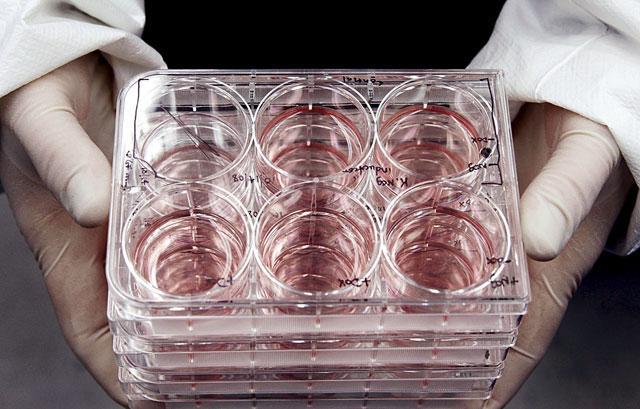
No other drug in the treatment of joint diseases has such a strong effect as stem therapy. The epiphyseal ends of the bones of the joints are covered with aseptic dead cells, which spread over the entire surface of the joints.
In the complex therapy of the disease, funds obtained from stem cells are used. Their action is due to the stimulation of the nutrition of diseased joints, the activation of metabolism in the patient's body. Thanks to the use of remedies, joint pain decreases or disappears without a trace. In the treatment of arthrosis, stem cells are injected systemically or locally into the area of the joint affected by inflammation.
Kartistem is a drug created on the basis of stem cells. It restores the function of damaged cartilage. The drug is injected into the tissues surrounding the knee joint. Stem cell funds have no side effects, and a stable improvement in the condition of the diseased organ is observed after the first injections of the drug.
Stem cell therapy completely prevents prosthetics of diseased joints.
Triaste for the treatment of destroyed cartilage
Many dietary supplements are used by physicians in the treatment of joint diseases. Triaste belongs to drugs of this type - a source of chondroitin sulfate and glucosamine. The vitamin complex is prescribed by the doctor after examining the patient.
The drug is available in tablets and is contraindicated in case of an individual patient's reaction to the constituent components. Also, the medicine is available in the form of a cream. In addition to glucosamine, it contains medicated oils ginger, turmeric, ceylon cinnamon tree, vitamin E.
The use of triaste restores mobility to the articular cartilage. After two courses of use, aching pains and a feeling of stiffness disappear, the range of motion in the affected joint increases. After application, the cream has a large-scale penetrating effect and has a beneficial effect on the entire patient's body.
Triaste tablets contain herbal ingredients and can be used for a long time. After their application, pains disappear in meteosensitive people, inflammation is eliminated. Treatment is carried out under the supervision of a doctor for a long time, until the condition of the diseased organ stabilizes.
The use of drugs for the treatment of arthrosis is available to every patient who, under the supervision of a doctor, wants to restore and strengthen the health of the knee joint and prolong youth and health.
Read the reviews of patients who have undergone treatment abroad. In order to receive information about the possibility of treating your case, leave us a request for treatment using this link.
Be sure to consult your doctor before treating diseases. This will help to take into account individual tolerance, confirm the diagnosis, make sure that the treatment is correct and exclude negative drug interactions. If you use prescriptions without consulting your doctor, then it is entirely at your own risk. All information on the site is presented for informational purposes only and is not a medical aid. All responsibility for the application lies with you.
